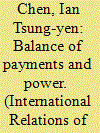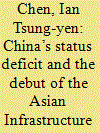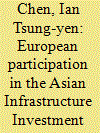|
|
|
Sort Order |
|
|
|
Items / Page
|
|
|
|
|
|
|
| Srl | Item |
| 1 |
ID:
138096


|
|
|
|
|
| Summary/Abstract |
Global economic imbalance leads to change in the global distribution of economic resources. While some foresee the inevitable decline of US power, others consider China’s forthcoming global primacy to be an exaggeration. This paper seeks to contribute to the debate by linking balance of payments (BOP) to power analysis. Dimensions of BOP are connected to Keohane and Nye’s two ideal-types of interdependence relationship: realist and complex interdependence. The former relates to the global distribution of aggregate economic resources; the latter emphasizes a detailed investigation of distinct interdependence situations between countries. China’s BOP from 1997 to 2012 is assessed through the lens of both ideal-type scenarios. The findings show that China’s growing power manifests principally in its rising status as a major global buyer in primary goods and its growing military strength in the region. However, China is confronted with possible slowdown in wealth accumulation and its lagging technological development. At present, the speculation of China’s upcoming global primacy may be exaggerated, but its dominant position in the region is indeed on the rise.
|
|
|
|
|
|
|
|
|
|
|
|
|
|
|
|
| 2 |
ID:
174733


|
|
|
|
|
| Summary/Abstract |
This paper seeks to explore whether the Asian Infrastructure Investment Bank (AIIB) has become an instrument of power led by China to fulfill her geopolitical interests. After an investigation of the AIIB’s power structure, institutional design, and its 34 approved projects, this study finds that although the AIIB deviates to some extent from international standards while considering loan decisions, the bank itself does not appear to be a norm challenger so far. Instead, it has become more cooperative and inclusive, with a shifting focus towards mutually beneficial cooperation and reform of the international financial system. This paper argues that the AIIB's current configuration results from the decrease in China’s status deficit—the gap between China’s recognized international financial status and its own perception of its financial power. Quantitative and qualitative evidence shows that when the idea of the AIIB was first conceived, China’s status deficit was large, which meant that in a global power struggle the AIIB was more likely to be manipulated by a dissatisfied China. As the AIIB evolved, China’s international financial status gained positive recognition and the AIIB received wider acceptance; China’s status deficit shrank. As a result, the AIIB has become a reform-minded multilateral financial institution that has made concessions to establish rules and has sought collaboration with its counterparts.
|
|
|
|
|
|
|
|
|
|
|
|
|
|
|
|
| 3 |
ID:
162505


|
|
|
|
|
| Summary/Abstract |
This paper asks why half of the members of the European Union (EU) have chosen to join the China-led Asian Infrastructure Investment Bank (AIIB) in defiance of substantial pressure from Washington. If the AIIB is too good an economic opportunity for Europe to ignore, then why did the rest of the EU turn its back on this organization? To account for this apparent variation in the attitude of European countries, I argue that, ceteris paribus, changes in the strategic situation involving Europe, the USA, and China, as well as differing expectations of economic opportunities in a developing Asia, have led European countries in different directions. Those countries which are getting increasingly friendly with China, which results from increasing level of alliance security dilemma with the USA, and are highly dependent on the potentially gigantic Asian market are the most likely to follow China’s lead. Countries that are not so geared toward China or Asia are least likely to join the AIIB. Where only one of these factors is present, the country will remain hesitant. I test this argument using both quantitative and qualitative analysis. This includes probit analysis for 31 countries and three in-depth case studies involving Germany, Belgium, and Romania. These countries have a high, median, and low chance of joining the bank, respectively. The findings of both types of analysis support the proposed analytical framework.
|
|
|
|
|
|
|
|
|
|
|
|
|
|
|
|
| 4 |
ID:
123108


|
|
|
|
|
| Publication |
2013.
|
| Summary/Abstract |
In the face of a rising China, some scholars have argued that ASEAN countries will choose to either bandwagon with or balance against China, while others believe they will respond with a more moderate policy known as 'hedging'. In considering these options, ASEAN countries must take into account their individual interests within the economic and security structure of this region. In this research, we argue that each ASEAN country confronts divergent sets of security and economic relations with China, which play a major role in shaping their policy responses. We can characterize their responses into four quadrants. Each cell can be categorized in terms of a high or low degree of threat perception (HT or LT) from China, as well as a positive or negative economic expectation (PE or NE) with China. We thus hypothesize that ASEAN countries in the HT-NE situation will balance against China; those in the LT-PE situation will bandwagon with China; those in the HT-PE or LT-NE situations will hedge against China. Hypotheses are supported by three case studies, Vietnam-China (HT-NE), Cambodia-China (LT-PE) and Singapore-China (HT-PE) relations.
|
|
|
|
|
|
|
|
|
|
|
|
|
|
|
|
| 5 |
ID:
143616


|
|
|
|
|
| Summary/Abstract |
Track II diplomacy is of specific strategic interest for Taiwan under the barriers of participation in international organizations and the formationof diplomatic ties with major powers. The Taipei-Seoul Forum/Seoul-Taipei Forum (TSF/STF), which was inaugurated in the early 1990s worked as an important example of how track II diplomacy can contribute to Taiwan’s relations with South Korea based upon interpersonal relationships and links between think tanks on either side. This paper examines the development of TSF/STF to examine the opportunities for and constraints on track II diplomacy efforts to nurture bilateral relations between Taiwan and South Korea. Through the lens of social capital as an analytical framework, this paper portrays the unique process of interpersonal social networking that takes place through TSF/STF, which has managed to preserve a fragile bilateral relationship during a period of extreme difficulty.
|
|
|
|
|
|
|
|
|
|
|
|
|
|
|
|
|
|
|
|
|